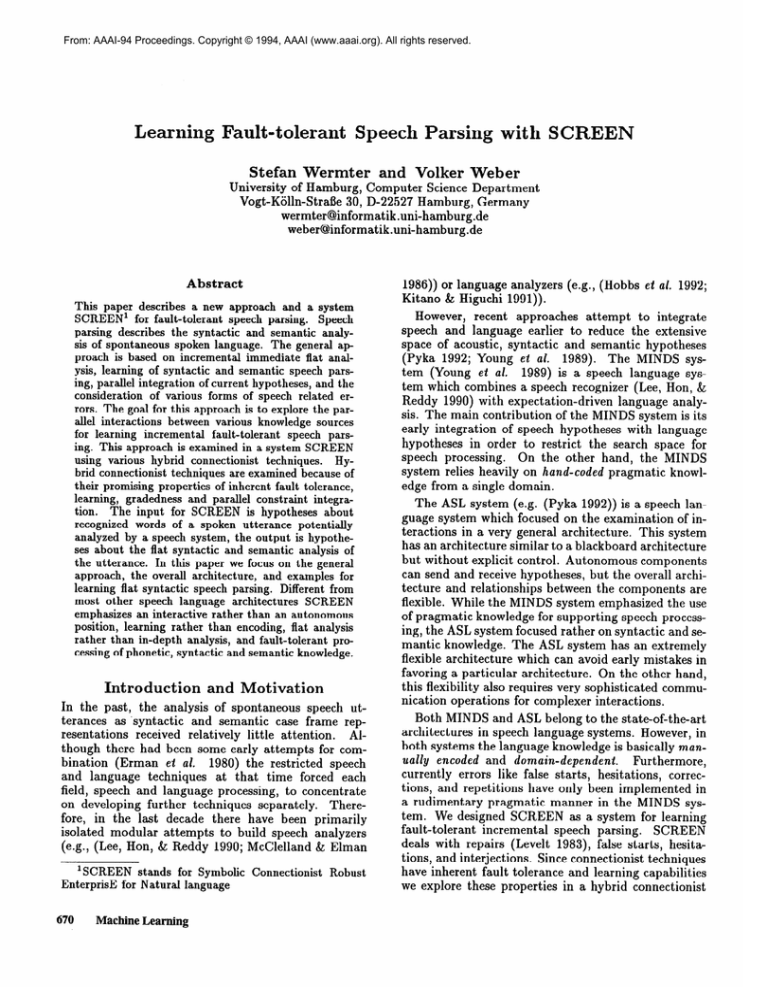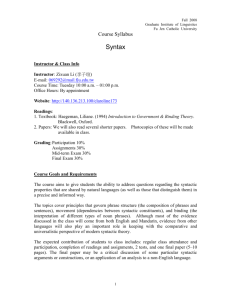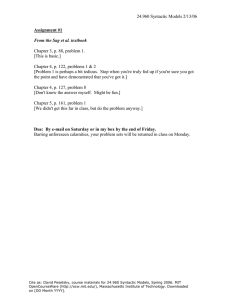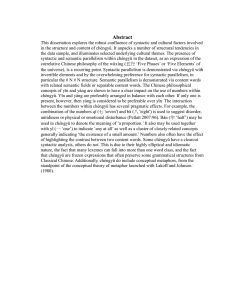
From: AAAI-94 Proceedings. Copyright © 1994, AAAI (www.aaai.org). All rights reserved.
Learning Fault-tolerant Speech Parsing with SCREEN
Stefan Wermter
and Volker Weber
University of Hamburg, Computer Science Department
Vogt-KSlln-Stral3e 30, D-22527 Hamburg, Germany
wermter@informatik.uni-hamburg.de
weber@informatik.uni-hamburg.de
Abstract
This paper describes a new approach and a system
SCREEN’ for fault-tolerant speech parsing. Speech
parsing describes the syntactic and semantic analysis of spontaneous spoken language. The general approach is based on incremental immediate flat analysis, learning of syntactic and semantic speech parsing, parallel integration of current hypotheses, and the
consideration of various forms of speech related errors. The goal for this approach is to explore the parallel interactions between various knowledge sources
for learning incremental fault-tolerant speech parsing. This approach is examined in a system SCREEN
using various hybrid connectionist techniques. Hybrid connection& techniques are examined because of
their promising properties of inherent fault tolerance,
learning, gradedness and parallel constraint integration. The input for SCREEN is hypotheses about
recognized words of a spoken utterance potentially
analyzed by a speech system, the output is hypotheses about the flat syntactic and semantic analysis of
the utterance. In this paper we focus on the general
approach, the overall architecture, and examples for
learning flat syntactic speech parsing. Different from
most other speech language architectures SCREEN
emphasizes an interactive rather than an autonomous
position, learning rather than encoding, flat analysis
rather than in-depth analysis, and fault-tolerant processing of phonetic, syntactic and semantic knowledge.
Introduction and Motivation
In the past, the analysis of spontaneous speech utterances as ‘syntactic
and semantic case frame representations received relatively little attention.
Although there had been some early attempts for combination (Erman eZ al. 1980) the restricted speech
and language techniques at that time forced each
field, speech and language processing, to concentrate
on developing further techniques separately. Therefore, in the last decade there have been primarily
isolated modular attempts to build speech analyzers
(e.g., (Lee, Hon, & Reddy 1990; McClelland & Elman
‘SCREEN
stands for Symbolic Connectionist
EnterprisE for Natural language
670
Machine Learning
Robust
1986)) or language analyzers (e.g., (Hobbs et al. 1992;
Kitano & Higuchi 1991)).
However, recent approaches attempt to integrate
speech and language earlier to reduce the extensive
space of acoustic, syntactic and semantic hypotheses
(Pyka 1992; Young et al. 1989). The MINDS system (Young et al. 1989) is a speech language system which combines a speech recognizer (Lee, Hon, &
Reddy 1990) with expectation-driven language analysis. The main contribution of the MINDS system is its
early integration of speech hypotheses with language
hypotheses in order to restrict the search space for
speech processing. On the other hand, the MINDS
system relies heavily on hand-coded pragmatic knowledge from a single domain.
The ASL system (e.g. (Pyka 1992)) is a speech language system which focused on the examination of interactions in a very general architecture. This system
has an architecture similar to a blackboard architecture
but without explicit control. Autonomous components
can send and receive hypotheses, but the overall architecture and relationships between the components are
flexible. While the MINDS system emphasized the use
of pragmatic knowledge for supporting speech processing, the ASL system focused rather on syntactic and semantic knowledge. The ASL system has an extremely
flexible architecture which can avoid early mistakes in
favoring a particular architecture. On the other hand,
this flexibility also requires very sophisticated communication operations for complexer interactions.
Both MINDS and ASL belong to the state-of-the-art
architectures in speech language systems. However, in
both systems the language knowledge is basically munuully encoded and domain-dependent.
Furthermore,
currently errors like false starts, hesitations, corrections, and repetitions have only been implemented in
a rudimentary pragmatic manner in the MINDS system. We designed SCREEN as a system for learning
fault-tolerant incremental speech parsing. SCREEN
deals with repairs (Levelt 1983), false starts, hesitations, and interjections. Since connectionist techniques
have inherent fault tolerance and learning capabilities
we explore these properties in a hybrid connectionist
architecture. In this hybrid connectionist architecture
we make use of learning connectionist representations
as far as possible, but we do not rule out symbolic representations since they may be natural and efficient for
some subtasks (e.g. for testing lexical equality of two
words) .
The data we currently use come from the German
Regensburg corpus2 which contains dialogs at a railway
counter (more than 48000 words). As a first step we
used transcribed real utterances of the Regensburg corpus for SCREEN. This corpus contains a great deal of
spoken constructions and occurring errors. In general
we also have to deal with other errors introduced by
the speech recognizer . However, for the purpose of this
paper we concentrate on transcribed real speech utterances in order to illustrate the screening approach for
speech parsing but our overall architecture SCREEN
has the long-term goal of using speech input directly.
In this paper we will first show the underlying principles of fault-tolerant speech parsing in SCREEN and
the overall architecture. Then we will describe results
from flat syntactic analysis with a hybrid connectionist
architecture using spoken utterances.
Principles of fault-tolerant speech
parsing with SCREEN
Our general approach is based on incremental immediate flat analysis, learning of syntactic and semantic
speech parsing, and the consideration of various forms
of speech related errors. The goal for this approach
is to explore the parallel interactions between various knowledge sources for learning incremental speech
parsing and to provide experimental contributions to
the issue of architectures for speech language systems.
Screening
approach
for
interpretation
level:
Since speech is spontaneous and erroneous, a complete interpretation at an in-depth level will often fail
due to violated expectations. Therefore, we pursue a
screening approach which learns an interpretation at a
flat level which is more accessible for erroneous speech
parsing. In particular, the screening approach structures utterances at the phrase group level.
Previous work towards this screening approach has
been described as scanning understanding in SCAN
(Wermter 1992). Th e scanning understanding primarily focused on phrase processing while our screening
approach goes further by integrating and extending
speech properties into a new system SCREEN for unrestricted robust spontaneous language processing.
Learning speech parsing: The analysis of an utterance as syntactic and semantic case frame representations is among the most important steps for language
understanding. However, in addition to semantic and
syntactic understanding per se, there are two central
aspects: learning and speech interaction. We examine
2For clarity the illustrated examples are shown in their
English translation.
to what extent hybrid connectionist techniques can be
used for learning and integrating semantic and syntactic case frame representations for speech utterances.
Dealing with errors: For building a speech language system we have to consider two main sources
of errors: errors at the speech level and errors at the
language level. Within a real speech system, errors are
based on incomplete or noisy input so that many incorrect words are detected. On the other hand, even under the assumption that a speech recognizer comes up
with the correct word interpretations for an utterance,
there are errors at the language level like repairs, repetitions, interjections and partially incomplete phrases
and sentences (e.g., telegraphic language).
SCREEN:
A system for fault-tolerant
speech parsing
SCREEN has a parallel architecture with many individual modules which communicate interactively and
in parallel similar to message passing systems. There is
no central control; rather messages about incremental
hypotheses at the current time are sent between specified modules in order to finally provide an incremental syntactic and semantic interpretation for a speech
utterance. For the realization, we use hybrid connectionist techniques. That is, we integrate connectionist
representations where they can be used directly and
efficiently, but we do not rule out the use of other
symbolic or stochastic representations. Connectionist techniques are examined because of their favorable
properties of inherent fault tolerance, learning, gradedness, and parallel constraint integration. Therefore,
SCREEN is not only an approach to examine faulttolerant speech parsing but also to test the extent to
which current connectionist techniques can be pushed
for building a real-world complex speech language system.
An overview
Figure 1 shows an abstract overview about the
SCREEN architecture. There are basically five parts
where each part consists of several modules.
Each
module can have a symbolic program and a connectionist network. The description of SCREEN as five
parts follows its main functionalities but does not suggest a fixed hierarchical architecture. Rather, the modules in the five parts work in parallel and can exchange
messages directly.
The speech interfuce part receives input from a
speech recognizer as word hypotheses and provides an
analysis of the syntactic and semantic plausibility of
the recognized words. This analysis can be used by
the speech recognizer for further speech analysis and by
the subsequent language parts for filtering only important plausible speech hypotheses for further language
analysis. The category part receives words of an utterance and provides basic syntactic, basic semantic as
Induction
671
In-depth Inferences
case frame part
1Learning
1 1-1
Flat
II
correction part I subclause part I Syntactic &
Speech recognizer
Figure 1: Overview of SCREEN
a sub-word level, word level, or phrase group level.
At the sub-word level the module PAUSE? checks if
a current input is a pause, INTERJECTION?
checks
whether it is an interjection or unknown phonetic input. At the word level LEX-WORD-E&?
checks if the
current word is lexically equal to the previous word
and BAS-SYN-EQ? (BAS-SEM-EQ?) if it is syntactically (semantically) equal to the previous word. The
modules at the phrase level are similar to the modules at the word level. LEX-START-EQ? checks if the
lexical start of two phrases is equal. ABS-SYN-EQ?
(ABS-SEM-EQ?) checks if the abstract syntactic (semantic) category of a current phrase group is equal to
the category of the previous phrase group. The output of the modules of the correction part described
so far is used in the error testing modules PAUSEERROR?, WORD-ERROR?,
and PHRASEERROR?.
PAUSE-ERROR? checks if a pause, interjection, or unknown phonetic input occurred, and WORD-ERROR?
(PHRASEERROR?)
determines if there is evidence
for a repair at the word level (phrase group level).
well as abstract syntactic and abstract semantic categories. The correction part receives knowledge about
words and phrases as well as their categories and provides the knowledge about the occurrence of a certain
error, like a repair or repetition. The subclause part
is responsible for the detection of subclause borders in
order to distinguish different subclauses. Finally, the
case frame part is responsible for the overall interpretation of the utterance. This part receives knowledge
about abstract syntactic and semantic categories of a
phrase and provides the integrated interpretation.
In the case frame part a frame is filled corresponding to the syntactic and semantic categories of constituents. The module SLOT-FINDING is used to
find the appropriate slot for a current phrase group.
SLOT-ERROR?
tests if the proposed slot is possible
based on the compatibility of abstract syntactic and
semantic categories for a current phrase group. VERBERROR? checks if new frames have to be generated.
INTERPRETATION
is needed to convert the internal
word-by-word message structure of SCREEN to a more
structured representation useful for further high level
processing.
A more
For illustration we focus on just a few modules for
flat syntactic parsing. The interface of a module is represented symbolically, the learning part of a module is
supported by a connectionist network. While not all
modules have to contain connectionist networks they
will be used as far as possible for automatic knowledge extraction. For illustrating the learned performance of some modules of SCREEN, table 1 shows
three modules with a simple recurrent network SRN
(Elman 1990), the number of units in the input I, hidden H, and output 0 layer. Training (testing) was performed with 37 (58) utterances with 394 (823) words.
We used the training instances (words) based on the
complete real world utterances including the errors.
Under the assumption of more regular than erroneous
language the general regularities will have been picked
up by the network, even if it has been trained with the
erroneous real-world data. For instance 99% (93%) of
the basic syntactic categories of the training (test) set
could be assigned correctly (see figure 2). The last
row describes the combined overall performance of the
modules BAS-SYN-DIS and ABS-SYN-CAT; only if
both SRN-networks provide the desired category with
maximum output activation it is counted as a correct
combined output.
detailed
overview
of SCREEN
Although we can not describe all the hybrid connectionist modules in SCREEN due to space restrictions,
we illustrate the overall architecture and some examples for individual modules (see figure 2). We focus
here only on the category part, the correction part,
and the case frame part, and within these parts we will
mainly focus on syntactic processing. The arrows illustrate incremental parallel flow of syntactic/semantic
hypotheses. All modules in the same part in figure 2
are able to work in parallel while the processing of an
utterance is incremental. While the modules in the
correction part analyze a certain word x the modules
in the category part are able to analyze the next word
x+1 and so on.
The category /part consists of the modules for disambiguating basic categories and determining abstract
categories. The module BAS-SYN-DIS (BAS-SEMDIS) disambiguates syntactic (semantic) basic categories. SYN-PHR-START (SEM-PHR-START)
determines the start of a new syntactic (semantic) phrase
group. The assignment of abstract syntactic (semantic) categories is performed by the module ABS-SYNCAT (ABS-SEM-CAT).
The goal of the error part is to detect errors at
672
Machine Learning
A Svntax/Semantics-Hvwtheses
Figure 2: SCREEN: some modules of the category, correction, and case frame parts
Module
No. of units
correct
assignments
~1
Table 1: Performance of some modules
An example
for speech
parsing
In this section we describe the incremental flat syntactic processing using two real transcribed utterances in
SCREEN. The first sentence in figure 3 does not contain a repair, while the second in figure 4 does. The
first sentence starts with the word “Yeah” which is
classified as adverb by the module BAS-SUN-DIS and
as part of modus group3 by ABS-SYN-CAT. At the
beginning of an utterance SYN-PHR-START classifies
a word as start of a new phrase group. The second
word “I” is classified as a pronoun, is part of a noun
group, and starts a new phrase group. The comparison of the first word (resp. first phrase group) and
second word (resp. second phrase group) does not
result in any hints for a pause-, word-, or phrase error. Later in the utterance the ABS-SYN-EQ? module
finds that the two syntactic phrase groups “from Regensburg” and “to Dortmund” are syntactically equal.
But syntactic equality of two phrase groups alone is
3interrogative pronouns and confirmation words
too weak to determine a phrase error since other modules (LEX-START-E&?
and ABS-SEM-EQ?) suggest
that these two phrase groups are different with respect
to their start and abstract semantic categories. When
the pause “.” occurs the module PAUSE-ERROR? is
triggered and the pause is deleted.
For this first utterance the analysis has been rather
straightforward while in the next utterance (see figure 4) we describe a more difficult example with error corrections.
PAUSEERROR?
is responsible for
deleting pauses, interjections, and phonetic material.
BAS-SUN-DIS classifies almost all interjections and
phonetic material correctly. Only “[u]” is misclassified
as adverb rather than interjection in BAS-SYN-DIS.
PAUSE-ERROR?
does not use this adverb information but only the output of PAUSE? and INTERJECTION?. As th e module PAUSE-ERROR? determines
these errors, interjections and pauses are deleted incrementally so that the phrase groups “at Monday” and
“at Monday” follow each other directly. Since both
groups are prepositional groups and since they have
the same lexical start the modules LEX-PHRASEEQ? and ABS-SYN-EQ? trigger PHRASE-ERROR?.
Therefore the first phrase group “at Monday . ..” is replaced by just “at Monday”. Similarly, other types of
repairs (e.g. “at Monday” replaced by “at Tuesday”,
“in the morning”) will be dealt with in the future.
Overall functionality
and performance
SCREEN provides a fault-tolerant interpretation of a
potentially faulty utterance. The words of the faulttolerant interpretation of the faulty utterance have
been underlined in order to illustrate this functionInduction
673
FAULTY FAULTTOLERA!NT
UTTERANCE
BASFi;-
ABSSYNCAT
- _M(;
Yeah
SYNPHRSTART
FAULTY/FAULTTOLERANT
UTTERANCE
when
BASSYNDIS
A
ABSSYNCAT
MG
8
VG
h
NG
leaves
need
VG
please
VG
a
train
NG
.
IG
NG
[ehl
IG
from
Regensburg
PG
PG
a
to
Dortmund
PC
.
PG
from
Jr&
PG
Regensburg
Koeln
PG
-to
Dortmund
PG
train
with
PG
at least
PG
at
tvo
PG
Monday
hours
PG
PC
cmd
Ctsl
Cd
time
-in
Koeln
PG
PG
positive
u
negative activation
strength of activation
size
Adjective, Adverb, Conjunction, Determiner,
Interjection, Numeral, Noun, Preposition,
Pronoun, Verb, - Pause
Conjunction Group, Interjection Group, Modus
Group, Noun Group, Prepositional Group, Special
Group,
Verb Group
SYNPHRSTART
m
IG
m
SG
.
IG
-at
Monday
.
morning
PC
PC
IG
PG
Figure 4: Sentence with corrections
Discussion
Figure 3: Syntax part of a sample parse of a sentence
ality in figures 3 and 4. Currently corrections occur
most reliably for interjections, pauses, unknown words,
and syntactic repairs with lexical equality of phrase
starts (as “at Monday” and “at Monday morning” in
figure 4). On the other hand, an example for a currently existing undesired interpretation is “eh . in the
morning at ten . in any case not after . not before
nine”. In this case “after” should be replaced by “before nine”. However, these two prepositional phrases
do not follow each other directly but there is an additional separating “not”. Currently SCREEN can only
deal with phrase repairs which follow each other directly since such repairs occur much more often (Levelt 1983). However, considering interjections, pauses,
unknown input, and simple forms of syntactically detectable repairs in our 95 utterances we currently reach
a desired overall interpretation
of 93%.
674
Machine Learning
We have described a screening approach to faulttolerant speech parsing based on flat analysis.
A
screening approach can particularly support learning
and robustness, which are properties that previous
approaches did not emphasize (Young et al. 1989).
The use of flat representations should stimulate further discussion since, in contrast to more traditional
speech language systems which used highly structural
hand-coded parsers, we use less structure but support
fault tolerance and learning better. Therefore, speech
parsers based on a screening flat analysis, learning, and
fault tolerance should be more scalable, adaptive and
more domain-independent.
Our approach to speech parsing is new since it makes
new contributions to general architectures for speech
parsing as well as new contributions to the hybrid
connectionist techniques being used. With respect to
the architecture we suggest a modular but interactive parallel architecture where modules exchange messages about incremental hypotheses without a particular control interpreter. With respect to the techniques
we proposed the use of hybrid connectionist representations. While certain subtasks (like the symbolic equality detection of incorrectly repeated words) can be realized best using symbolic techniques, there are other
subtasks with incompletely known functionality where
fault-tolerant connectionist learning is advantageous.
The work which is closely related to ours is the connectionist PARSEC parser for conference registrations
(Jain 1992), the hybrid connectionist JANUS speech
translation system (Waibel et al. 1992), and the hybrid
connectionist SCAN system for general phrase analysis
(Wermter 1992). In g eneral, connectionist techniques
in PARSEC, JANUS, SCAN and SCREEN particularly support learning necessary knowledge where possible. However, SCREEN focuses more on exploring
interactive parallel architectures and more on modeling fault tolerance.
Currently, the overall architecture as well as all the
syntactic modules in SCREEN have been fully implemented, trained, and tested for a corpus of utterances with 1200 words. Although the overall SCREEN
project is at an intermediate stage we believe the new
architecture and the finished syntactic modules contribute substantially to new fault-tolerant learning architectures for speech language systems. Further work
will focus on additional semantic modules for faulttolerant case-role assignment and the top down interactions to speech modules in order to reduce the search
space of speech hypotheses.
Conclusion
We have described the architecture and implementation of a new speech parser which has a number of innovative properties: the speech parser learns, it is parallel and fault-tolerant,
and it directly integrates incremental processing from speech into language processing
We have illustrated the processusing flat analysis.
ing in SCREEN with flat syntactic analysis, but in a
similar way we are currently pursuing a flat semantic
analysis. On the one hand, flat analysis can provide
a parallel shallow processing in preparation for a more
in-depth analysis for high-level dialog understanding
and inferencing. On the other hand, flat analysis can
potentially provide necessary restrictions for reducing
the vast search space of word hypotheses of speech recognizers. Therefore, learned flat analysis in a screening
approach has the potential to provide a new important intermediate link in between in-depth processing
of complete dialogs and shallow processing of speech
signals.
Acknowledgements
This research was supported in part by the Federal
Secretary for Research and Technology (BMFT) under
contract #OlIVlOlAO
and by the German Research
Community (DFG) under contract DFG Ha 1026/61. We would like to thank Matthias Lijchel, Manuela
Meurer and Ulf Peters for their assistance with labeling
the corpus and training various networks.
References
Elman, J. L. 1990. Finding structure in time. Cognitive Science 14(2):179-211.
Erman, L. D.; Fennell, R. D.; Lesser, V. R.; and
Reddy, D. R. 1980. The HEARSAY-II speech understanding system: Integrating knowledge to resolve
uncertainty. Computing Surveys 12(2):213-253.
Hobbs, J. R.; Appelt, D. E.; Tyson, M.; Bear, J.; and
Israel, D. 1992. SRI international: description of the
FASTUS system used for MUC4. In Proceedings of
the Fourth
Message
Understanding
Conference.
Jain, A. N. 1992. Generalization performance in PARSEC - a structured connectionist parsing architecture.
In Moody, J. E.; Hanson, S. J.; and Lippmann, R. P.,
eds., Advances in Neural Information Processing Systems 4. San Mateo, CA: Morgan Kaufmann. 209-216.
Kitano, H., and Higuchi, T. 1991. Massively parallel
memory-based parsing. In Proceedings of the 12 th
International
Joint
gence, 918-924.
Conference
on Artificial
Intelli-
Lee, K.; Hon, H.; and Reddy, R. 1990. An overview of
the SPHINX speech recognition system. IEEE Transactions
on Acoustics,
Speech,
and Signal
Processing
38( 1):35-45.
Levelt, W. J. M. 1983. Monitoring and self-repair in
speech. Cognition 14:41-104.
McClelland, J. L., and Elman, J. L. 1986. Interactive
processes in speech perception: The TRACE model.
In Rumelhart, D. E.; McClelland, J. L.; and The PDP
research group., eds., Parallel Distributed Processing:
Explorations
in the Microstructure
of Cognition, volume 2., Psychological and Biological Models. MIT
Press, Bredford Books. chapter 15, 58-121.
Pyka, C. 1992. Management of hypotheses in an integrated speech-language architecture. In Proceedings
of the 10 th European
ligence, 558-560.
Conference
on Artificial
Intel-
Waibel, A.; Jain, A. N.; McNair, A.; Tebelskis, J.; Osterholtz, L.; Saito, H.; Schmidbauer, 0.; Sloboda, T.;
and Woszczyna, M. 1992. JANUS: Speech-to-speech
translation using connectionist and non-connectionist
techniques. In Moody, J. E.; Hanson, S. J.; and Lippmann, R. P., eds., Advances in Neural Information
Processing Systems 4. San Mateo, CA: Morgan Kaufmann. 183-190.
Wermter, S. 1992. A hybrid and connectionist architecture for a SCANning understanding. In Proceedings of the 10th European
telligence, 188-192.
Conference
on Artificial
In-
Young, S. R.; Hauptmann, A. G.; Ward, W. H.;
Smith, E.; and Werner, P. 1989. High level knowledge
sources in usable speech recognition systems. Communications
of the ACM 32:183-194.
Induction
675









